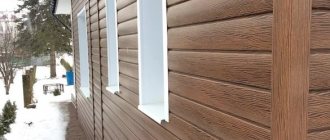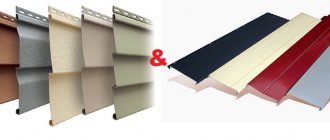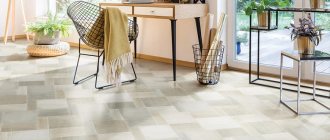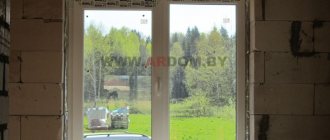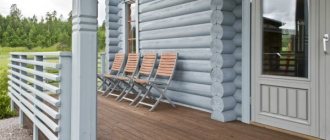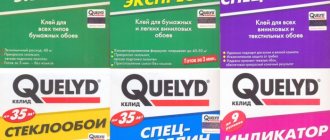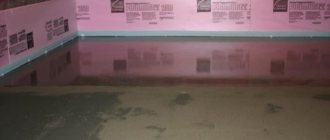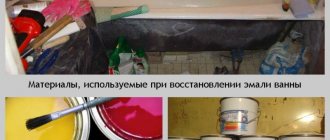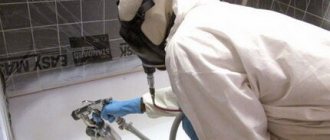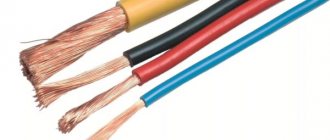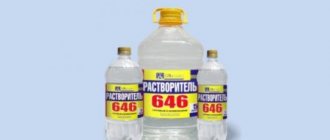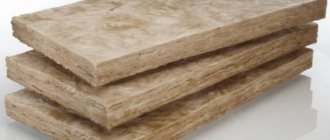There are many ways to decorate a house externally, from budget to very expensive, and each of them has its own advantages and disadvantages. However, siding has held the leading position on the market for many years. It is used for cladding the facades of residential buildings, industrial buildings, warehouses, garages and much more. Nowadays, a huge number of varieties of siding have appeared on the building materials market, differing in material of manufacture, color, and performance characteristics. But which siding is better? The answer to this question can be found in the article.
Which siding is better
What is siding, what are its features?
What is siding
Today, private owners actively use not only siding, but also facade panels, and these concepts are often equated, which is not entirely true. Within the framework of this material, we will consider siding - narrow long elements in the form of a double or single “board” with a fastening system. The main difference between facade panels and siding is not even the greater width and shorter length, but the installation technology. The panels are assembled onto the sheathing without the use of a connecting strip; when installing siding on long walls, you cannot do without it. Siding is produced in lengths from three to six meters; the shorter the planks, the more joints there will be on the facade - to level out this transition, siding is combined with panels or other finishing. When you need classic cladding a la an American house, when choosing which siding collection is best, you should give preference to cladding of maximum length.
Visually, siding resembles wood paneling, but with different effects:
- smooth surface, as if covered with a layer of covering paint, practically without texture, painted in all the colors of the rainbow;
- “board” under glaze or oil, with a pronounced texture, reliably imitating the natural patterns and shades inherent in valuable wood.
Depending on the type of siding, high quality imitation is achieved either through painting alone, or through a set of combinations of multi-tone coloring and a textured surface. If you are considering what kind of siding to cover a house like wood with greater reliability, you should prefer textured cladding.
Criteria for choosing material for cladding
To choose the right finishing material, carefully understand how its options differ, evaluate all operating factors:
- Price. A decisive parameter that usually influences the choice. The difference in this regard is significant: vinyl material is cheaper. If you calculate the total finishing area that will be obtained by covering the entire facade, the difference is so huge that homeowners cease to doubt what to prefer.
- Accessories. It is also necessary to take into account the need to purchase additional accessories for installation. If you choose acrylic finishes, they will also cost more, which will increase the overall cost.
- Climate. The nature of the climate for a particular area plays an important role in the choice of cladding. When ultraviolet rays actively affect the cladding, prefer a material that is resistant in this regard. Then acrylic is better. To save money, we recommend that when purchasing material, you make a calculation so that you cover only those surfaces that face the sun with expensive plates. Cover the remaining walls with vinyl siding, choosing the appropriate combination of shades.
- Installation option. Although the principle of assembling any lamellas is almost the same, there are still slight differences between different materials. They consist of different fastening locks. Since this parameter does not affect the overall functionality of the cladding, it can be ignored. The installation algorithm is almost identical: first the walls are prepared, then the frame is created. Then the strips are attached to the facade.
Regarding further use, the requirements are identical: any material can be washed with mild, non-aggressive detergents. If necessary, damaged elements can be easily replaced without disturbing the rest of the surface at all.
Summarizing the listed properties, it is necessary to emphasize that acrylic material benefits only in terms of a greater variety of colors and resistance to ultraviolet rays. Only the homeowner can decide whether such benefits are worth paying more for.
Why is siding so popular?
Siding is consistently in demand among owners of suburban real estate due to real, not mythical, advantages.
Versatility - can be used on all types of foundations, both new and existing or reconstructed residential and non-residential buildings. Any house, bathhouse, garage or outbuilding can be given the desired look, regardless of the load-bearing capacity of the enclosing structures. It is enough just to select the type of cladding that best suits the initial conditions and specific operating conditions.
Practicality - high-quality siding is a material that is “set and forgotten”; it does not need to be painted, treated with antiseptics or water repellents, either immediately or over time. Dirt is easily washed off with plain water from a hose, if there is a drain and a blind area, you won’t even need a Karcher. But when choosing which siding will be better for your home, you should take into account external factors - if there is a street nearby with active traffic and clouds of dust, there will be more problems with light textured surfaces. It makes sense to look towards smooth planks, from which dirt will be washed away by rain without the intervention of the owners. If you can’t bear it, like you want ash or bleached oak, and even so that it feels “like wood,” it’s worth paying more and getting cladding with a repulsive surface.
Availability - it consists of an acceptable cost even for products of famous brands, good coverage of all regions by dealer networks, and the possibility of installation on your own.
Easy installation - the manufacturers' instructions are comprehensive, no space technologies, subsystems to choose from, you only need the most basic tools. It is quite possible to quickly cope on your own when you have the time and desire.
There is no connection to the season - the installation of the subsystem and the siding itself in the process of finishing the house does not involve wet processes and can be carried out all year round. They manage to work both in severe frosts and on hot afternoons, but if there is no dire need, there is no need to abuse the body and the material.
Reliability - siding not only transforms the facade, but also protects the walls of the house from atmospheric factors and mechanical influences. If the cladding of the previous generation was fragile and began to “walk” after the first season, modern materials from responsible manufacturers are durable and resistant to linear expansion, and are not afraid of the sun, rain and snow, wind, or pests. However, when choosing which siding to choose for your home, you should take into account the climate zone - some types are designed for severe frosts, others for hot summers, and others for year-round extreme operation. And this could be not only high humidity and the “wind blowing from the sea” day after day, but also air that is far from the canons of cleanliness or those who like to test the strength of the skin with their own fists.
Durability - for exclusive collections of famous domestic and foreign brands, the warranty period today is fifty years, for their simpler upholstery, thirty years. This period is more than enough for any façade material; you will get tired of it a hundred times over, and fashion will change, and children will want to do it their own way. Plus, the guarantee covers the safety of both operational properties and presentation for the entire service life.
Aesthetics – even luxury siding is not capable of surpassing the natural original in terms of decorativeness, but almost all well-known brands were able to come as close as possible to it. If you carefully think through the layout and, even at the stage of choosing the best siding for your home, take into account all the nuances, it is quite possible to end up with an interesting, presentable facade, and not a “stall”. And no matter how much opponents of imitations blame siding for its artificiality, the demand for budget collections that vaguely resemble wood, and even in uncharacteristic colors, is consistently high.
Features and installation steps
When deciding which siding to choose, you need to remember the installation features inherent in each type of cladding. We will take a closer look at installing vinyl, as it is the most common.
Many stages of work (for example, installation of sheathing) are also suitable for cladding walls with other materials.
Installation of sheathing
Installation of the sheathing is the first and one of the most important stages of installation work. It is on it that the siding panels are held, it allows you to organize insulation and provide facade ventilation. You can make a sheathing from:
- wooden beam measuring 50 by 50 cm;
- metal profile of guide and stand type in combination with special connectors.
At the first stage of arranging the structure, the walls are marked - the frame will be built up according to the markings. Install the sheathing bars perpendicular to the position of the future panels. The step between wooden beams should be no more than half a meter.
Installation of the metal frame begins from the corners, and the pitch of the profiles is the same as that of the timber. The system is secured using nails and screws. The metal frame is additionally framed at the final stage.
Waterproofing
Waterproofing material is required. Today, special membranes are used in its role, which are laid directly under the panels. There must be a gap between it and the insulation or vapor barrier film.
Insulation
Even high-quality and inexpensive siding made of plastic or metal will not provide proper insulation of the house. The use of additional materials is required. Therefore, the question of which siding is really better is answered by deciding on the available insulating materials.
In modern construction work, mineral wool, polystyrene foam, synthetic polyfoam, glass wool and even insulating plaster act as insulation materials.
Install the selected material immediately after organizing the sheathing. They fill the voids, having previously been lubricated with construction glue.
In some cases, an additional frame is created, where another layer of insulating material is placed - this method is called cross. Additional fasteners may be used.
Panel installation
The installation of facing panels begins not only after insulation and waterproofing work, but also after checking the entire structure for plumb and level.
When choosing the best siding for cladding a house, the shape of the wall to be covered is also taken into account. To fasten the panels to the sheathing, galvanized self-tapping screws of no more than 20 mm are used, after making holes if there are none initially. Do not allow the panel to be pressed against the sheathing.
The bottom starting strip is attached first along the pre-drawn marks. After fastening, install the external and internal corners. Maintaining distances plays an important role - the upper distance from the wall is 6 mm, and the lower one is 2 cm. If the joining of the panels does not overlap, you must remember to install H- and J-profiles that complete the planks.
All installation work on cladding is carried out from the bottom up. Each subsequent panel is snapped using a hook-lock to the groove of the previous one and tucked into the elements covering the ends. As in the case of the first, all panels are fastened with self-tapping screws or nails in such a way as to prevent the effects of thermal expansion from occurring.
Siding Burnout
Burnout of siding was considered its main disadvantage, inherent in all types of material, regardless of the brand and raw material base. And the first series that appeared on the market really lost a lot in color, even in pastel colors, after just a season or two. But since stabilizers began to be introduced into the composition, and the quality of applied paint and varnish coatings has improved by an order of magnitude, fading has ceased to be a problem. No, it has not yet been possible to completely prevent fading under the influence of ultraviolet radiation, but this process occurs slowly and evenly.
A slight loss of brightness can be noticed with the naked eye only when comparing new siding of the same range with what has been serving on the facade for several years. But only when we are talking about high-quality products from well-known, time-tested brands, and not no-name products from the nearest market. Here is an excellent example of how cladding remains presentable over time.
olesya31FORUMHOUSE participant
The house was built about twelve years ago, and then it was covered with Canadian vinyl siding. To be honest, there is almost nothing to complain about - the facade is still pleasing to the eye.
DiulimFORUMHOUSE member
We spent a long time choosing which siding was best, we settled on a vinyl block house from a domestic manufacturer and we are very pleased with the material. During all this time, no problems arose; we did it and forgot it. Despite the rich color, it has not faded in the sun, there are no cracks or waves between the panels, although four years have already passed.
It is impossible to be 100% insured against burnout; defects also happen with responsible manufacturers, but much less often and the chances of “getting caught” are lower. Plus, if such a situation arises, it is easier to file a complaint and get a replacement or refund from a major brand.
Choosing siding step by step
The quality of the facade finishing and the appearance of the building largely depend on the choice of siding. Since all types of material have their advantages and disadvantages, it is important to correctly assess the operating conditions of the siding and many other factors so that the finish will serve for many years and be pleasing to the eye, but will not require additional repairs and restoration.
Step 1. First of all, it is important to assess your financial capabilities and operating conditions of the material. This will largely determine what the siding should be made of. The advantages and disadvantages of each type of material are described above. Note that the most durable is acrylic/vinyl siding, while wood siding lasts the least.
Types of siding for cladding a house
Step 2. You need to choose the color of the panels and their texture. They must meet not only wishes, but also the conditions of use. It is best to give preference to light colors, as dark ones will get too hot in the sun. And they don’t fade so noticeably.
On a note! If you have the desire and means to make your house exclusive, you can directly contact the siding manufacturer and offer him to produce siding with an individual pattern and geometry according to the customer’s wishes.
Popular siding colors
Step 3. The quality of painting of each panel should also be assessed. Painting must be done on both sides, and the surface must be smooth, without roughness (if it is not textured). If paint is only on the outside, this is an indicator of poor-quality siding.
Natural wood effect, natural wood effect series
Step 4. The cut thickness of the panel of material, which should be the same throughout the cut, also deserves special attention. Otherwise, the panel may become deformed in hot weather.
Pay attention to the panel cut thickness
Step 5. Temperature resistance also needs to be assessed. The greater the temperature range of the material, the better.
The permissible ambient temperature is also important
Siding problems
Step 6. You should choose a plastic and fairly flexible material (we are not talking about wood or fiber cement). Siding when bending a corner should bend, and not crumble or break.
Step 7. For a beginner who is going to install siding on their own for the first time, you should pay attention to the ease of attaching the panels. Each type of material has its own recommendations for strengthening on the facade of a house. It is better to choose the one that is easiest to install.
Covering a house with siding is slightly reminiscent of decorating the interior with plastic panels
Step 8. In order not to redo the siding in a couple of years, it is better to choose the most durable and high-quality material.
How to choose the right siding for your home
Step 9. You should request fire safety certificates from the seller.
Sample fire safety certificate
Types of siding
id20226314FORUMHOUSE member
Siding has deservedly justified popularity among cladding materials for exterior decoration of buildings. This is what led to the appearance of a significant number of its types, types, sizes and colors.
Many sources also classify edged boards, clapboards, planks, imitation timber or logs and other natural wood cladding as one of the types of siding, which is wrong. At one time, the Americans organized the production of polyvinyl chloride siding precisely as an alternative to classic wooden siding for the house. And later other materials were added to it, but also imitating and replacing wood. Today, in any region, the following types of cladding are available for sale and on order for every taste, color and budget.
- Vinyl siding.
- Acrylic siding.
- Foam siding.
- Metal siding.
- Fiber cement siding.
For cladding a house, which siding is best?
Let us briefly summarize all of the above to help you decide which siding to choose for finishing the facade of your house.
- Vinyl siding is an inexpensive, common and relatively easy to install type of siding. Among the main disadvantages are the high rate of fading and the high coefficient of thermal expansion, which must be taken into account when carrying out installation work. The budget lines of this siding do not have an elegant appearance. However, despite these disadvantages, vinyl siding is an excellent budget facade material and performs its functions well. If a low budget is important when choosing facade cladding for your home, and you are ready to accept the fact that your facade will fade over time, feel free to choose vinyl siding.
- Acrylic siding is, in most respects, very similar to vinyl siding, but is much more resistant to fading and is more expensive. Choose it if you need a compromise option between vinyl siding and more expensive facade materials.
- Metal siding is a fairly reliable type of siding, absolutely non-flammable, making it suitable for finishing municipal and commercial buildings. However, when choosing siding for a private home, it is better to consider other types of materials.
- Fiber cement siding and fiber cement facade panels are a reliable, durable facade material characterized by a wide selection of textures and colors. Premium material with a guaranteed service life of 50 years and an actual service life of over 100 years, a guarantee against visible fading for 30 years. Significant disadvantages of this material include its high cost and high complexity of work due to the mass of the material and the need for special equipment for installation, the need to order material from abroad. Choose fiber cement siding if you need a premium design, durable facade.
What else you need to remember when choosing material for facade finishing:
- Consider the location of the building. For a building located in the forest among trees, vinyl siding is enough to reliably protect it from the sun’s rays. If the structure is constantly exposed to ultraviolet radiation, it is better to take acrylic.
- Check certificates of quality and origin in advance. Undocumented material with a below-average price can cause a lot of problems. If there are different sizes of siding in one batch, its installation will become a real headache.
- Choose siding from one batch for one wall of the house, because... There may be differences in color between batches, which is not considered a manufacturing defect and does not serve as a basis for a warranty replacement of the material.
- Buy siding from one manufacturer, calculating in advance the required volume for finishing with a small margin. Even if the material looks the same, it may react differently to prolonged exposure to temperature, moisture, and sunlight.
- Uneven walls require special care to build the sheathing so that after installing the slabs the walls look perfectly even.
- The rich color indicates high resistance to fading. The material will cost more because it contains more expensive pigments. To choose the right combination of colors for the roof, walls, and facade elements, you need to consult with professionals.
How to choose the right manufacturer
- View the catalog of facade materials on our website. Our assortment includes only proven manufacturers of facade materials.
Myths you shouldn't pay attention to
When wondering which plastic siding is better, it is necessary to take into account that often the generally accepted opinion runs counter to reality. Often myths are born due to gross miscalculations made during installation or operation.
- Plastic finishing stimulates the appearance of condensation on the walls. — Properly assembled lathing of a ventilated façade guarantees free passage of air, which allows excess moisture to be quickly removed. If installers attach panels directly to the wall, condensation occurs.
- When exposed to sunlight, the panels will release toxic substances that are harmful to the body. — When buying certified siding, you don’t have to worry because each batch undergoes a thorough check of compliance with SanPiN.
- After several years of operation, the facade decoration loses its attractiveness due to the destruction of the siding. — Numerous tests of certified products show that the material, manufactured in accordance with existing standards, serves for many years, without any problems withstanding temperature fluctuations, humidity, and strong gusts of wind.
EXPERT OPINION Roman Bodarov, customer service manager of the installation department of the FRONTMASTER company
When choosing which siding is better, give preference to what fully meets current needs. Minor savings can lead to serious financial costs in the future.
Vinyl siding
Initially, it was produced from polyvinyl chloride using the monoextrusion method - single-layer strips, painted in the mass or by applying a layer of paint and varnish. It could not boast of particular strength, durability or presentability, but even then it served for 10-15 years, although with a spoiled appearance. Nowadays, various modifiers are added to PVC, which significantly increase its technical and operational properties. Plus, high-quality vinyl siding is now produced using co-extrusion (two layers) or triple extrusion (three layers) technology. Each layer has its own functionality - the top layer is responsible for presentation and resistance to atmospheric influences, and the inner layer is responsible for strength and resistance to linear expansion and mechanical stress. But even with this design, vinyl siding is inferior to metal and fiber cement in terms of strength and still “walks” due to seasonal fluctuations, which must be taken into account during installation. The exception is three-layer siding, designed specifically for extreme operating conditions. It is durable, almost like metal, and retains its geometry at any time of the year and at any temperature.
The decorative effect of current vinyl siding is at its best; manufacturers have expanded the range to the maximum and have mastered not only panel embossing, but also thermal printing. The combination of several shades, coupled with a textured surface, allows vinyl to accurately replicate the pattern and color scheme of natural wood. But such visual and tactile effects are inherent in luxury collections, although budget series also look quite attractive.
Vinyl siding is available in the form of a single or double plank, with a profile of herringbone (American), block house (log), ship timber (ship plank) and laminated veneer lumber. The dimensions of the panels depend on the specific brand, but on average the thickness varies from 1.0 to 1.2 mm, and the length of the panels is 3 and 6 meters.
Which insulation to choose?
Siding can be laid directly on the walls - on wooden strips attached with dowels. You can lay insulating material between the elements:
- polystyrene,
- mineral wool.
What is the best insulation?
First you should consider which method of sheathing installation is chosen:
- dry - with nails, screws;
- wet - for glue, solution.
A light dry method is usually used for siding. The dry method is quite simple, accessible, and it is advisable to use it for self-cladding and insulation. If the dry method is chosen, insulation is carried out without the use of adhesives, mortars, or other materials containing water. All layers are attached mechanically using nails, screws, and paper clips. This method involves laying thermal insulation on the walls, between the structure of the lamellas on which the siding is attached.
Mineral wool
Mineral wool slabs are most often used as insulation under siding. These are soft elastic plates that fill the space between the elements of the supporting structure for facade panels.
Properties of mineral wool:
- Mineral wool is a vapor-permeable product, giving the walls the opportunity to “breathe”, allowing water vapor to pass out.
- Does not absorb moisture from the air.
- Easy installation.
- Thanks to its elasticity, mineral wool will tightly fill the insulated space.
- Classified as a non-combustible material (fire reaction class - A1), the use of mineral wool increases the safety of the insulated object.
- Low heat transfer coefficient guarantees good thermal properties. For example, for PANELROCK mineral wool the heat transfer coefficient is 0.036 [W/m∙K].
- The mineral wool slab has a thickness of 10-15cm. The board is not glued to the wall, it is located between a wooden or metal grate, so no surface preparation is required. The grille is attached to the load-bearing wall using metal fasteners.
The slabs are laid tightly in one layer and fastened with connectors. A ventilation gap of approximately 1.5 cm wide should be left between the insulation and the vertical siding. To ensure the effectiveness of thermal insulation, the next step is wind insulation. The insulation must be made of polyethylene film with high vapor permeability (1300 g/m²/24 hours).
Polystyrene
Polystyrene can be installed as thermal insulation. However, even the precise placement of rigid thermal insulation boards between the slats of a wooden lattice can be complicated by the creation of thermal bridges. But even in this case, there are effective solutions.
Siding captured the market in the 90s of the last century, but then it was quickly replaced by more modern solutions. Now it is coming back into fashion. Unusual, original finishing methods are becoming increasingly common, giving buildings an aesthetic appearance. This durable, weather-resistant facade can be used for many years without the need for repairs. Modern siding has great aesthetic value. “Dry” technology allows panels to be installed throughout the year, regardless of weather conditions.
The technical parameters of modern siding from leading manufacturers have been verified by extensive testing. The check includes:
- impact strength,
- shrinkage
- color uniformity,
- shine,
- flexibility at low temperatures,
- thickness of the outer layer.
The resulting final product is characterized by high quality and has a guarantee of up to 50 years. Siding facades do not rot like wood or rust like metal. The shape and design guarantees the tightness of the connection, the absence of moisture inside, allowing the walls to “breathe”.
Modern siding - photo
Acrylic siding
More precisely, it is not acrylic, but vinyl, but with an acrylic decorative and protective top layer, which provides the material with increased color fastness. In everyday life, such cladding is stubbornly called acrylic not only by consumers, but also by manufacturers, but it doesn’t make much sense to figure out which siding is the best, acrylic or vinyl. Acrylic siding has the same advantages as vinyl, but thanks to the top layer of ASA (Acrylnitril-Styrol-Acrylester), it is better resistant to ultraviolet radiation and practically does not fade. Therefore, the darkest and most saturated shades of wood or non-trivial ones are often found in acrylic cladding. The coating provides resistance to elevated temperatures (up to +80 °C), but does not add strength. In this regard, acrylic siding is also inferior to metal, but if you do not set out to pierce or pierce it, it will withstand accidental mechanical impacts, like other vinyl.
Description of the material and manufacturing process
Siding refers to panels made of various materials, including PVC, which cover the facade surface of the building, having previously organized the lathing. If we are talking about vinyl sheathing, then it is made by extrusion.
To produce metal, steel sheets are coated with a primer.
And fiber cement requires the use of a cement-fiber mixture. The purpose of the material is not only to improve the appearance of the house, but also to provide additional insulation.
Foam siding
Also vinyl with an acrylic decorative protective coating, also co-extrusion and two layers, but the structure of the panel itself is different - the base foams when molded and hardens in this form. The thickness of the board is 6-14 mm, which has a positive effect not only on strength and resistance to damage, but also on presentability. Due to the greater thickness, the embossing is deeper and the quality of wood pattern imitation is higher, and thanks to acrylic, the shades are brighter, resistant to high temperatures and have maximum color fastness. The panels are produced in the form of a single board with a fastening system; there is no variety of profiles - only a herringbone for all occasions.
Metal siding
Metal siding differs from metal tiles and corrugated sheets only in the dimensions of the planks and the type of profile; otherwise, the base is made of galvanized steel sheet, with a protective and decorative polymer coating on the outside and a protective primer on the inside. The siding profile is standard - board, log, ship timber, laminated veneer lumber. The thickness of the steel base varies in the range of 0.45-0.65 mm, zinc should be at least 100 g/m². How resistant metal siding will be to fading, atmospheric and mechanical influences depends on the type of polymer film. The most common is polyester, which gives the cladding a characteristic gloss. Unlike vinyl siding, metal siding imitates wood only visually, due to high-precision color printing; the planks do not have a characteristic texture. But the quality of imitation, especially in exclusive collections, is at its best.
The main advantage of metal siding is its high strength, but although it does not break, dents remain, and this does not add to the presentability of the facade. Disadvantages include less durability of the material. Despite the fact that the service life of the metal is calculated in decades, during operation the protective layers are damaged and corrosion begins. Because of this, the warranty on metal siding, even from luxury collections with a high zinc content and pural instead of polyester, averages 20-30 years.
Market Review
The manufacturer is of great importance when choosing siding. The fact is that the service life, the quality of the material, its strength, the rate of fading and much more will depend on this.
Table. Foreign manufacturers of siding panels.
| Company manufacturer | Characteristic |
| Variform | An American brand that is distinguished by the quality of its products. Market tested. |
| Mitten | Canadian siding with a wide variety of colors. Very expensive, but proven material. |
| Gentek | High Canadian quality. The main competitor of the previous company. |
| Royal | Polish brand, but very expensive compared to domestic brands. Usually this siding is bought only because of the wide variety of colors, but in terms of quality it can be replaced with domestically produced material. |
| Vytec | Another Canadian company that produces siding. Durable and high quality, but, like other imported materials, expensive. |
| Vox | Belarusian siding, which is often positioned as Belgian. Not bad material. |
Royal Siding
Prices for metal siding Grand-Line
Table. Russian manufacturers of siding panels.
| Company manufacturer | Characteristic |
| Dock | Perhaps the most popular in Russia. The production plant is located in Moscow. Often offered by sellers as German, but this is not the case. It is inconvenient to install, and components often deteriorate in the sun. |
| "Northside" | Siding from St. Petersburg. Very high quality material at a reasonable price. |
| Fine Ber | Novosibirsk company. Too difficult to install, which is why it is not popular. But the price is quite high. |
| Tecos | Siding from Tver. Often appears to be Belgian. The price is high, but the quality is excellent. |
| "Alta-Profile" | High-quality material from Moscow. Small selection of colors, fades quickly, but is easy to use. |
Attaching siding to a wooden house
In order to ensure that the cladding of a wooden house with vinyl or metal siding is done to the highest possible quality, additional elements that are required for finishing window and door openings, gables, and slopes are purchased simultaneously with the panels. Read this article for more details.
Video - Choosing siding
Fiber cement siding
It appeared last, but has already managed to prove itself from the best side both in terms of decorativeness and technical and operational characteristics. It is produced by autoclave hardening from a mixture of fiber (cellulose fibers), cement and additives, in the form of single boards with the texture of natural wood or a smooth surface. The thickness of the planks varies from 8 to 12 mm, the length is only 3600 mm, which is quite logical, given the increased weight of the cladding.
Thanks to the raw material base and production technology, the material surpasses all other types in strength and durability and can be used in any aggressive conditions. Fiber cement also conveys the pattern of natural wood best and, accordingly, looks more authentic. But this type will fade on a par with ordinary vinyl, slowly and imperceptibly, clearly inferior to acrylic. The main complaint is the high cost of both domestic and imported fiber cement siding.
Operation and care
In terms of ease of use and surface care, plastic is unrivaled. Its smooth surface is easy to clean from dust and dirt. Even severe scratches are invisible on it, since surface damage does not lead to discoloration.
Metal siding is also easy to maintain. But any scratches must be painted over to restore the appearance and corrosion protection of the facade.
Fiber cement siding, like plastic siding, is insensitive to minor damage. The disadvantage may be some porosity of the material. It can make the surface difficult to clean, and in some cases it can develop a green residue on the siding that is very difficult to remove.
